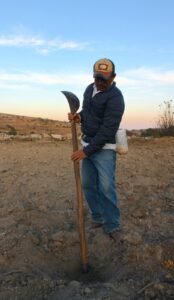With the support of the Program of Small Donor of the Organization of United Nations, hand-in-hand with the Intercultural University of the State of Mexico, during the 2023 and 2024 we have been doing a project in the Mixteca Alta of Oaxaca, in the municipality of Tlacotepec Plumas. The people of the village are actively involved in the recovery process of their language, the language ngigua, and the traditions chocholtecas of the region, in addition to be working to be recognized as native people.
A large part of the population is engaged in the field, although there is an increasing migration to urban centres and the united States; therefore, fewer people young people continue the practices of their fathers, mothers, and abuelxs. By the adverse weather conditions, here we saw how they have developed different ways of cultivating, using crops that with the passage of time, relationships and caring for their cultivadorxs, have adapted to the extreme environment.
One of these varieties is the corn cajete whose name comes from the pit, which is done with a coa in the soil for seeding, which takes the form of “cajete” with a depth of about 30 centimeters. After cycles of adaptation to the soil and local climate conditions, the corn cajete has developed an impressive resistance to drought – born only using the using the low-moisture stored in the earth, the last of the rains, and thus manages to grow during the next three or four months of drought before the start of new rainfall.






In addition, during the rainy season they grow what they call corn of temporary, both white varieties such as blue, that are usually planted in conjunction with other plants of the corn crops, such as beans and squash. Another important species for the food culture of Tlacotepec Plumas is wheat, of which there are two varieties commonly grown. One is the wheat temporary and the other is a type of wheat who called ‘adventurous’, which like the maize cajete has adapted to the extreme climate of the area. This type of wheat owes its name to the great resilience to frost and drought that has.
Pot of water catchment






